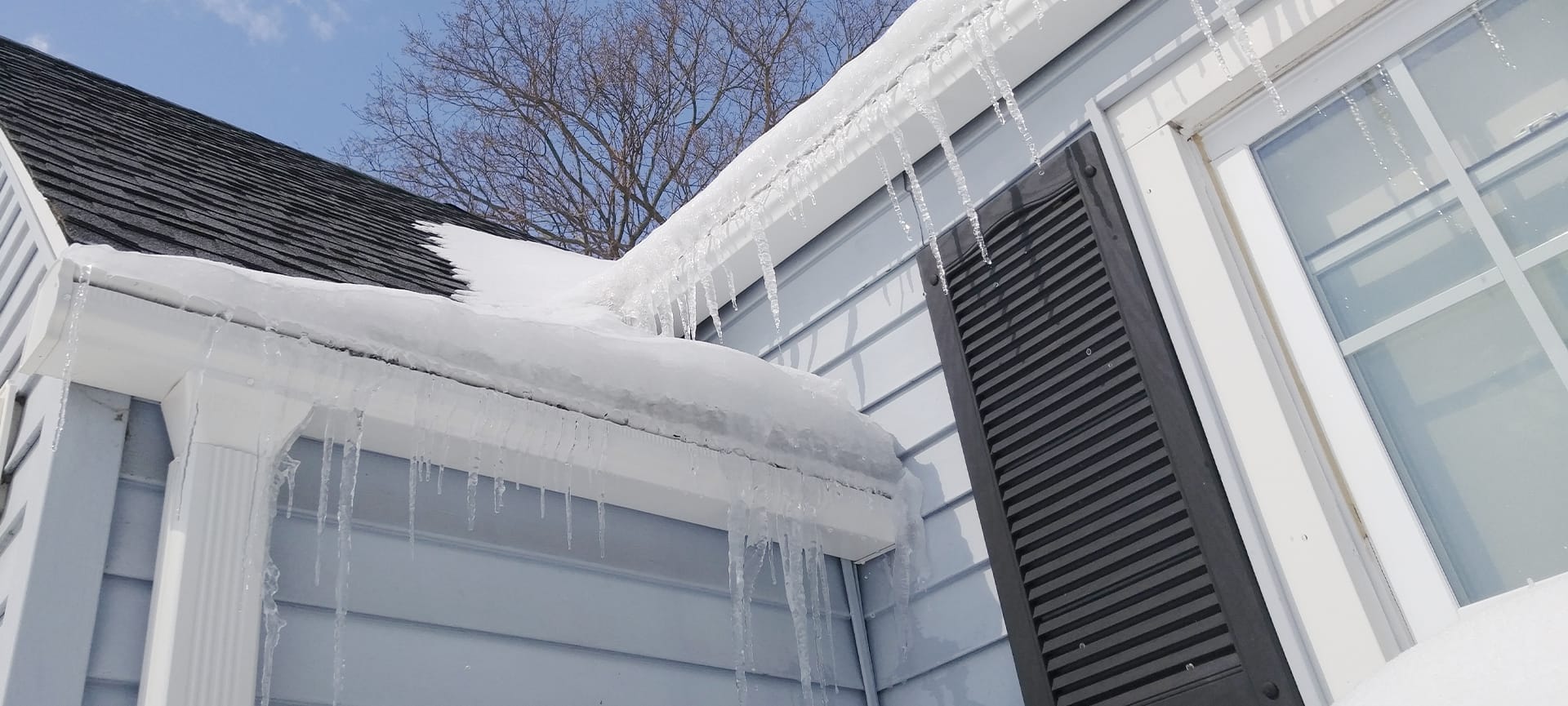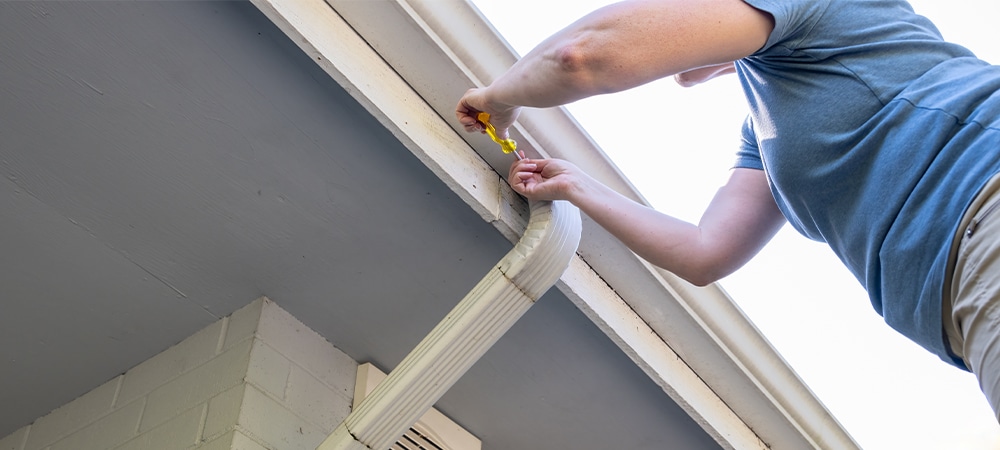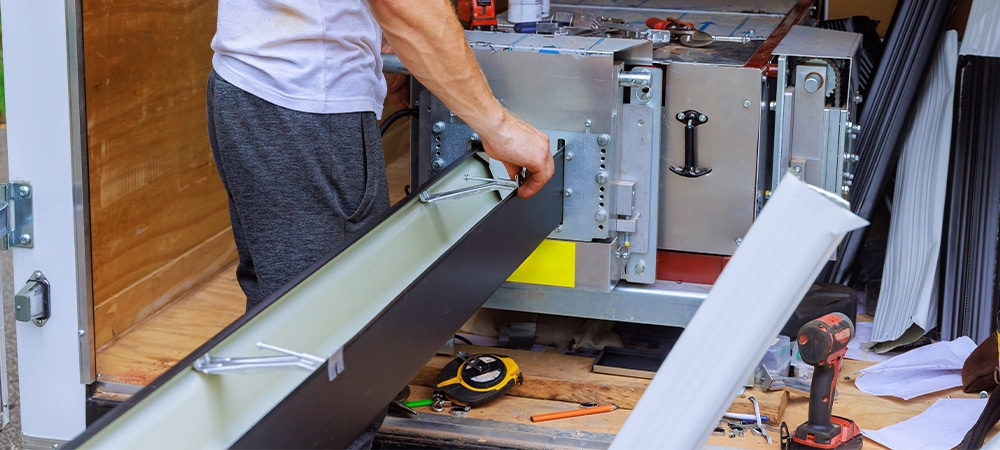
When the first real cold snap hits the GTA, many homeowners look up and notice a new winter hazard: thick ridges of ice hugging the roof edge and clogging the eavestrough. Left unchecked, that frozen dam can push meltwater under shingles, stain interior walls, and send sheets of ice tumbling onto walkways.
The good news? Most ice build-up is preventable with a mix of routine maintenance and a few strategic upgrades. Use the checklist below to keep water moving and your home safe right through spring thaws.
Related Article: How Much Does It Cost to Replace Eavestrough
Why Ice Forms in Eavestroughs
Even a brand-new gutter can freeze solid overnight if three factors line up: heat loss, blockage, and sudden temperature swings.
- Escaping heat — Warm air leaking into the attic melts roof snow from beneath. The runoff refreezes at the unheated eaves, forming an ice dam.
- Debris dams — Autumn leaves, twigs, and shingle grit slow drainage, giving cold air more time to freeze the pooled water.
- Freeze–thaw cycles — When daytime highs creep above 0 °C and nights plunge below, meltwater repeatedly stops and starts, layering ice like growth rings on a tree.
Understanding these triggers makes the prevention steps much clearer.
Related Article: How to Winterize a Swimming Pool
Inspect and Clean Before the Snow Arrives
An early-November gutter cleanout is the cheapest insurance you can buy against winter headaches.
- Remove all leaves and sediment by hand or with a scoop, starting at each downspout.
- Flush with a garden hose to confirm full flow. Water should exit within two seconds of entering.
- Tighten loose fasteners and replace missing brackets so sections don’t sag and hold water.
- Seal minor seams with cold-weather polyurethane caulk — don’t postpone to spring; small drips turn into icicles fast.
Finish with a final visual scan from ground level. If light shines through joints or you spot bent sections, plan repairs now while ladders are still safe to use.
Improve Attic Insulation and Ventilation
A warm attic is enemy number one when fighting ice. Boosting R-value and airflow pays lifelong dividends.
Small fixes add up. A single afternoon spent sealing gaps around pot-lights or topping up thin spots with blown-in cellulose can drop attic temperatures by five degrees and stop melt lines from ever forming.
Ensure Proper Eavestrough Slope and Downspout Flow
Gutters should pitch a minimum of 6 mm for every 3 m of run. Grab a 600 mm level and check:
- Place the level on the eavestrough bottom; the bubble should touch the upslope line.
- Adjust hangers rather than forcing the entire length. Aluminum tolerates mild bending, but over-cranking screws can warp the profile.
- Confirm downspout elbows aim straight into a clear leader extension at least 1.8 m from the foundation. Frozen downspout shoes are the leading cause of mid-winter back-ups.
If you own a two-storey house, consider adding an intermediate outlet halfway along long runs; shorter drainage paths equal fewer freeze points.

Install Leaf Guards and Baffles
Screen or mesh guards keep new debris out without trapping snow. Choose aluminum or stainless steel micro-perforated panels for the best balance of strength and flow.
- Guards block up to 95% of organic matter, cutting cleanouts to once every two years.
- They also prevent late-season leaves (often still falling in December) from clogging half-frozen gutters overnight.
- Baffles inside the valleys channel high-volume runoff so it lands in the trough, not over it, reducing ice curtains on exterior walls.
While guards cost more upfront than an open system, the payback in reduced ladder work and winter risk is quick, usually two to three seasons.
Add Heat Trace Cables: When to Consider Them
Heating cables sit on top of shingles above the eavestrough, creating channels that keep water flowing even when outside temperatures drop to −20 °C.
- Best for north-facing roofs, cathedral ceilings with limited insulation depth, or sections over skylights where snow melts unevenly.
- Run a dedicated GFCI-protected circuit and install a thermostat that switches on around −4 °C. Leaving cables on nonstop wastes energy and can over-dry shingles.
- Arrange cables in a zigzag pattern from 30 cm above the exterior wall line down into the gutter and partway through each downspout.
Remember: heat cables solve symptoms, not causes. Combine them with insulation upgrades for a lasting fix.
Use a Roof Rake After Heavy Snowfalls
When storms dump more than 15 cm, pull fresh snow off the first metre of roofline before it can melt and refreeze.
- Stand on solid ground; never climb onto an icy roof.
- Work the rake upward, allowing snow to slide off without scraping shingles.
- Clear evenly along the whole eaves length to prevent load imbalances that stress trusses.
- Keep piles away from basement windows and gas metres where meltwater can pool.
Ten minutes with a roof rake reduces the weight pressing on gutters and cuts the volume of water heading toward potential ice dams.
Related Article: Preventing Ice Build-Up: Effective Strategies for Commercial Properties
Professional Eavestrough Maintenance and Upgrades
Some jobs (re-sloping long runs, installing seamless aluminum, or adding rigid foam baffles) are best left to qualified crews with the right safety gear. Hiring a pro delivers:
- Precise pitch adjustments using laser levels rather than eyeballing.
- Custom-formed seamless troughs up to 35 m long, removing weak points where ice likes to start.
- Proper soffit vent retrofits that balance intake and exhaust airflow in one visit.
If you’re in the GTA or York Region, Green Side Up Contracting offers year-round gutter care backed by an 11-time HomeStars award record. A quick assessment now can save drywall, insulation, and peace of mind later.

Winter Safety Tips Around Ladders and Ice Removal
Ice prevention only works when the work itself is safe.
- Choose fibreglass ladders; aluminum rails conduct cold and become slippery fast.
- Wear non-skid boots and avoid carrying tools in hands; use a belt.
- Never chip ice with metal shovels or axes. They dent gutters and slice sealant. Opt for plastic mallets or deicing pucks designed for aluminum.
- Keep children and pets clear of the drop zone when removing snow or icicles. Falling chunks weigh more than expected.
Treat every winter maintenance session like a mini construction project: plan, equip, execute, and exit without shortcuts.
Related Article: Are Landlords Responsible for Snow Removal in Ontario, or the Tenants?
Winter-Ready Gutter Plan
Consistent upkeep is your best defence. Clear debris before freeze-up, verify the eavestroughs still pitch toward open downspouts, and stop attic heat from escaping so meltwater can’t refreeze at the eaves.
Add guards, baffles, or heat cables where you know ice likes to form, and rake heavy snow after storms to lighten the load. When the work demands extra gear or know-how, bring in a certified crew. A few deliberate moves now keep water moving all winter, saving you from drywall stains, warped fascia, and mid-season ladder runs.
Master these steps now, and winter will bring glistening snow banks and, not stubborn ice ridges, around your home. When in doubt, call in a certified crew to correct pitch or install seamless systems safely.
Need a hand winter-proofing your gutters? Book a free on-site inspection today and keep water moving where it belongs, away from your roof and foundation.



